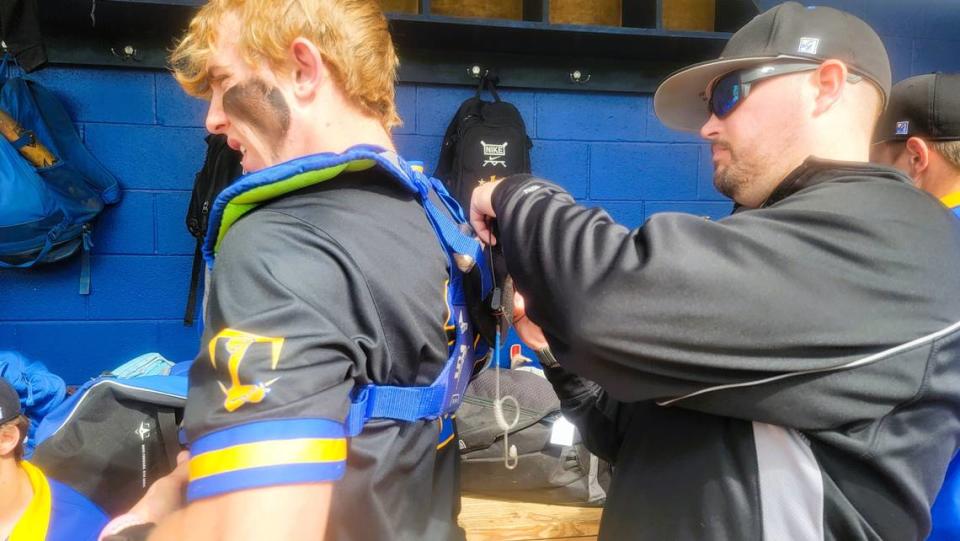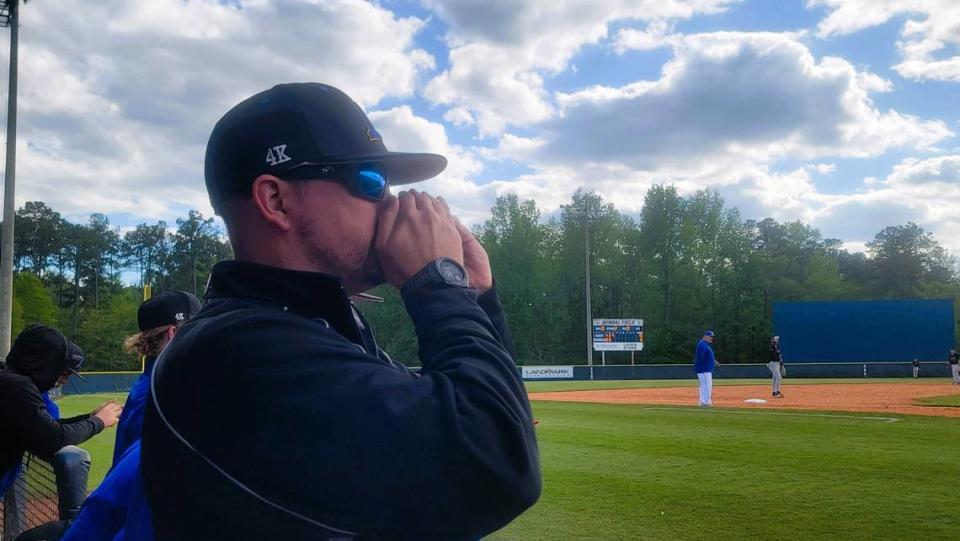How SC high school baseball teams are leaning into new communication technology
Lexington catcher Jackson Cionek was almost set.
The sophomore had almost all of his catching gear on as he got ready to take the field last week for the Wildcats’ matchup against Dreher in the SC Diamond Invitational at Blythewood High School.
Cionek was just missing one thing — his earpiece. Lexington pitching coach Dell Lever grabbed the earpiece and strapped the device to the back of Cionek’s chest protector strap as Cionek put his earpiece in his right ear.
That scene in the Lexington dugout is a common one in SC and across the country as the National Federation of High Schools is allowing electronic communication in high school baseball this season.
Under the new rule, a head coach or assistant is allowed to give signs and communicate any other instructions to the catcher during the game.
“It is a little weird at first trying to get used to it,” Cionek said. “It felt so weird like my pitching coach was right behind me, talking to me. After a while, you get super used to it. You get tired of looking at the dugout to get calls so you can look straight forward at the pitcher and give him the signs. So, it is super cool and really convenient for the catcher.”
High school baseball is following the lead of Major League Baseball and college baseball with the use of electronic devices. MLB adopted the use of them before the 2022 season after positive feedback from use in minor leagues in 2021 and in spring training in 2022.
College baseball has been allowing catchers to have an earpiece in their helmets since 2018.
“This change is consistent with the growth of the game and is indicative of a measured and responsible approach to enable technology into our level of competition,” NFHS Director of Sports and Educational Services Elliot Hopkins said in a release when the rule went out this summer. “The committee has made these changes to maintain the balance between offense and defense; increase the pace of play; and will responsibly manage technology so there is no advantage gained by schools that have more available resources than some of their contemporaries. Creating a level playing field is paramount to education-based athletics.”
The NFHS doesn’t make the use of electronic communication mandatory so teams can still send pitches in the old way by looking at the coach in the dugout. SC Baseball Coaches Association Executive Director Art Boozer estimates between 60-70 percent of teams across the state are using an electronic communication device.
Of the 15 Midlands high school baseball coaches responding to The State’s survey, 12 of them said they use some sort of electronic communication this season. All 12 said it definitely helps with increasing the pace of play.
“Absolutely,” Dutch Fork coach Casey Waites said. “I think it works for sure.”

In addition to the pace of play, another obvious benefit is avoiding sign stealing from teams. Lever and Dutch Fork pitching coach Darren Jones cup their hands around the walkie-talkie as they are signaling pitches.
Waites and Lexington coach Brian Hucks were a little skeptical about them at first but now both coaches really like the use of them. Most of the teams in the area use the walkie-talkie style device that costs around $1,800-$2,000. There are different makes that might be as low as between $600-800.
“I like the aspect of going away from the old-school wristbands or signs where we can have a conversation with our catcher,” Hucks said. “From that aspect, it is a good thing.”
Chapin uses the Pitch-Com device that pitching coach Paul Scheno taps on the keypad and a computerized voice relays pitch and location to catcher Caden Reeves. Scheno has the keypad programmed specifically for each type of pitch and location.
The Eagles are leasing the Pitch-Com for $750 for the year rather than buying it. They have had a positive experience with it and with the help from Pitch-Com help support in case they ever have a problem
Chapin coach Scott McLeod said they opted for Pitch-Com because it is what is used in the major leagues, plus it will help with the transition with the next phase in high school communication — allowing pitchers to listen to the signals in their hat or on a wristband.
Some coaches in the area believe pitchers could be able to use communication devices as early as next season.
“I think as it goes on and the pace of play goes faster, it definitely is something we can see down the road,” Hucks said.


